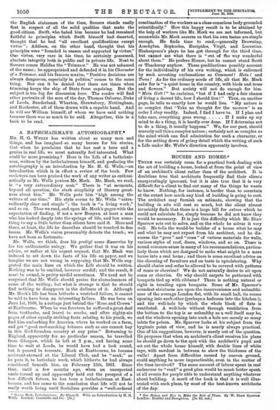HOUSES AND HOMES.* THERE was certainly room for a practical
book dealing with the art of building a house, looked at from the point of view of an architect's client rather than of the architect. It is doubtless true that architects frequently find their clients exasperatingly ignorant, but it is also true that it is very difficult for a client to find out many of the things he wants to know. Nothing, for instance, is harder than to ascertain at the outset how much any kind of building is going to cost. The architect may furnish an estimate, showing that the building in situ will cost so much, but the client almost invariably finds that there is a large bill for extras which he could not calculate for, simply because he did not know they would be necessary. It is just this difficulty which Mr. Shaw Sparrow sets out to solve, and on the whole he solves it very well. He tells the would-be builder of a house what he may and what he may not expect from his architect, and he dis- cusses the "pros" and "cons " of various materials for walls, various styles of roof, doors, windows, and so on. There is sound common-sense in many of his recommendations, particu- larly those which are designed to make what might be a mere house into a real home ; and there is some excellent advice on the choosing of furniture and on taste in upholstering. Why should chairs and sofas be allowed to be covered with patterns of roses or cherries? We do not naturally desire to sit upon roses or cherries. Or why should carpets be patterned with bouquets tied up with ribbons P There is nothing natural or right in treading upon bouquets. Some of Mr. Sparrow's soundest strictures are upon the inconvenience and unhealthi- ness of the average London flat, with its small hall, its rooms opening into each other (perhaps a bedroom into the kitchen!), and the well-hole by which the whole block of flats is ventilated. A well-hole without through ventilation from the bottom to the top is as unhealthy as a well itself may be, and the windows opening into such a hole are merely so many inlets for poison. Mr. Sparrow looks at his subject from the hygienic point of view, and he is nearly always practical. One of his suggestions, however, is surely out of the question. He proposes that when an architect's client receives his plans he should go down to the spot with the architect's pupil and set out the whole house himself, with double lines of white tape, with sawdust in between to show the thickness of the walls ! Apart from difficulties caused by uneven ground, could anything be more impracticable, even in the matter of the time involved? The same amount of labour spent in real endeavour to "read" a good plan would be much better spent, at all events for people able to understand anything whatever about building. A merit of the book is that it is well illus- trated with such plans, by most of the best-known architects of the day.
• Our Homes and How to Make the Best of Them. By W. Shaw Sparrow. London: Hodder and Stoughton. [7s. ed. net.)






















































 Previous page
Previous page